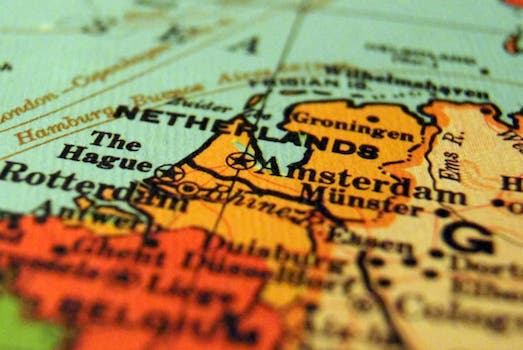Netherland facts is a stunningly colorful country that not everyone knows about. But even if you are a diversified person or have been to this state, some interesting facts will definitely surprise you. You probably didn’t know this!
Brief Information About The Netherlands Facts
As a country, the Netherland facts occupies a substantial chunk of Western Europe as well as a smattering of Caribbean isles. The North Sea washes over a small portion of the land, and the countries of Belgium and Germany are close by. While Amsterdam is technically the seat of government, The Hague serves as the country’s de facto second-biggest city since it is home to the royal family, several embassies, and the country’s parliament.
Useful information! The flag of the Netherlands consists of three horizontal stripes: red, white and blue (in order from top to bottom). And the coat of arms looks like a shield supported on the sides by two heraldic lions and topped with a crown. On the shield itself is depicted a crowned powerful lion standing on its hind legs, holding a sharp sword in one of its paws. Under the shield is the motto of the kingdom, which translates literally as “I will stand.”

The Most Interesting netherland facts
The Netherlands is a fantastic country, and here are the ten coolest and most interesting things you should know about it.
- About the title. Moreover, half of the territories in the Netherlands are at or below sea level, hence the term “Netherlands” is a fitting and natural description of the country’s topography. Dams and windmills designed for pumping water and regulating its level are used by the country to weather the water element (there are more than a thousand mills in total). By the way, as on January 1, 2020, the state stopped using the alternative name, leaving simply “the Netherlands.” There are rumours that the locals dislike it when their state is referred to as “Holland,” as just one historical region, made up of the present-day provinces of South and North Holland, is thus named.
- About population growth. The Dutch have long held the title of world’s tallest people. An average guy is, thus, roughly 1.83 metres tall., and the average woman is about 1.69 m. This phenomenon has received several explanations. The first is hereditary predisposition, that is, genetics. The second explanation is the highest level and decent quality of healthcare. And the third reason is a full and balanced diet, a rich and healthy diet of the population.
- About bicycles. There are more units of two-wheeled transport in the Netherlands than the inhabitants of the state themselves. Surprisingly, this is true: the population is about 17 million people, and the number of bicycles is about 18 million. Such vehicles are actively used here and are very popular, and among them there are not only standard models, but also the so-called “bakfiets”, which are tandems of bicycles and wheelbarrows (adults carry children on them, for example, they deliver them to schools). By the way, such vehicles are often subject to theft, and sometimes residents spend even more on locks and anti-theft systems than on the vehicles themselves.
- About talents. Yes, the Dutch are incredibly talented: many world-famous artists were born and learned the basics of creativity in this colorful country, inspired by its special atmosphere and stunning views. Many famous artists worked in the Dutch Golden Age, including Willem de Kooning, Jan Vermeer, Rembrandt, Jan Steen, and even Vincent van Gogh. And right now, just in the greater Amsterdam area, there are a lot of works: 206 by Van Gogh and at least 22 by Rembrandt.
- About flowers. Tulip fields in the Netherlands are world-famous for their size, beauty, and incredibleness, and the country also hosts many renowned flower shows and festivals. Though they are now widely recognised as a symbol of the country, tulips were first imported from the Ottoman Empire in the seventeenth century. More than 75% of the world’s bulbous flower species originated in the Netherlands, making it the world’s largest supplier of flowers today.
- About freedom of morals. It’s no secret that the Netherlands is the most liberal country in the world. For example, the use of soft drugs such as marijuana is absolutely legal here. Since 2000, at the legislative level, it has been allowed to engage in prostitution and use sex services. In 2001, the Netherlands lifted the ban on legal marriages for same-sex couples. And since 2009, homosexuals have been allowed to adopt and raise children here.
- About drugs. As you know, light drugs are legalized in the Netherlands, that is, for example, the use of marijuana is not prohibited here and is not punishable by law. At home, the Dutchman has the right to grow up to five cannabis bushes, but for personal needs. But at the same time, the level of consumption of this drug is surprisingly one of the lowest in Europe. And the state also recorded low mortality rates associated with the use of narcotic substances – only eight deaths from an overdose per million people. Among other things, the quality of drugs can be checked, and at the expense of the state at the request of consumers.
- About traditions. The culture and traditions of the country are another proof of the freedom of morals of its inhabitants. For example, almost no one here curtains the windows and does not hesitate to flaunt their private lives. But such a tradition has ancient roots and is determined by religious Protestant moral standards, according to which honest people have nothing to hide behind curtains, because their lifestyle is fully consistent with Christian canons. And the baths here are public, that is, there is no sexual separation, and women bathe together with men. Moreover, it is customary to visit steam rooms naked. And it doesn’t bother anyone at all.
- About alcohol. Alcohol in the Netherlands is treated very positively. Moreover, juniper vodka, famous for its strength and specific aroma, is considered a favorite drink of local residents. But low-alcohol drinks are also in vogue here: beer is also loved and drunk in truly impressive quantities (up to 74 liters of foam per capita per year). And the second largest and one of the first famous Heineken breweries is located in Amsterdam. It is customary to drink strong beer here in winter to warm up the body, and lighter varieties are popular in spring. But the Dutch cannot be called drunkards and alcoholics: they do not devote their lives to drinking alcohol, they know when to stop and do not drink too much.
- About food. The Dutch almost never eat full hot meals, limiting themselves to sandwiches and simple snacks. But here they are very appreciated, loved and, of course, they know how to cook cheeses of various varieties. In the spring, local gourmets feast on herring, which is prepared in the Netherlands in a special way and turns out to be incredibly tender and tasty. For more information visit our website.
You May Also Like:- How To Choose The Right Dress In The Online Store



